Home Insulation Concerns
- You can save up to 20%-25% in energy cost with the correct insulation choices.
- There are tax rebates for specific types of insulation.
- Your heating and cooling system will be affected long term.
- Are you aware of the cost differences with the varities of insulation.
- What is R value and how does it effect your choice in insulation products.
Thermal Protection - Insulation
www.certainteed.com/products/insulation/fiber-glass-insulation/
www.certainteed.com/products/insulation/spray-foam-insulation/
Thermal insulation is the reduction of heat transfer (the transfer of thermal energy between objects of differing temperature) between objects in thermal contact or in range of radiated influence. Thermal insulation can be achieved with specially engineered methods or processes, as well as with suitable object shapes and materials.
Heat flow is an inevitable consequence of contact between objects of differing temperature. Thermal insulation provides a region of insulation in which thermal conduction is reduced or thermal radiation is reflected rather than absorbed by the lower-temperature body.
The insulating capability of a material is measured with thermal conductivity (k). Low thermal conductivity is equivalent to high insulating capability (R-value).
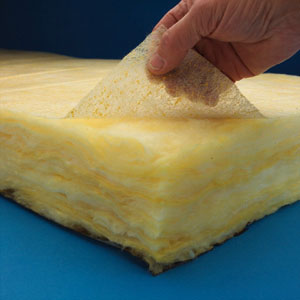
Insulation in the home is very valuable, but at the same time could cause a quandary or dilemmas. People are susceptable to allergies and/or colds, therefore it will be important to make sure the home is ventilated properly in order to move clean air throughout. Insulations are being manufactured at a frenetic pace without thought to how they might impact our environment and health.
Flame retardant chemicals are added to foam insulations. Building insulation are their primary application.
The "Too Tight" Theory
The “too tight” theory holds that houses need to breathe. Traditionalists can point to old houses and claim the only reason they’re still standing is because air leaks amount to natural ventilation that dries everything out and keeps the house healthy.
In reality, air leaks mean you’ve lost control of air movement. Air and moisture can be forced into wall and ceiling cavities where water vapor condenses and fosters the growth of mold. Warm air exiting the top of the house can draw in cold air to replace it, wasting heat and energy. In many ways, uncontrolled air movement wastes energy and increases the risk of long-term damage to building components.
Effective air and moisture barriers reduce those problems, but they come with a few caveats: Tight houses need mechanical ventilation to ensure a supply of fresh air to keep people healthy; and existing houses should not be tightened without assessing whether the existing combustion appliances have an adequate source of combustion makeup air.
As far as insulation goes, there may be a theoretical point of “too much,” but in most cases buildings have too little. At the very minimum, insulation should meet recommendations of the Department of Energy, but adding more is always a good thing. Properly insulated buildings are cheaper to heat and cool.
 Where insulation is added can be as important to how much is added. Walls and roofs with an extra layer of rigid insulation outside the framing help cut energy losses due to thermal bridging. What’s more, some types of insulation are inherently more effective than others. But using too much should be the least of our worries. Does energy efficiency come with health risks? Newer homes are energy efficient thanks to state-of-the art insulating materials now widely used. But new research raises concerns about potential health risks, posts Kalliopi Monoyios for Scientific American.
Where insulation is added can be as important to how much is added. Walls and roofs with an extra layer of rigid insulation outside the framing help cut energy losses due to thermal bridging. What’s more, some types of insulation are inherently more effective than others. But using too much should be the least of our worries. Does energy efficiency come with health risks? Newer homes are energy efficient thanks to state-of-the art insulating materials now widely used. But new research raises concerns about potential health risks, posts Kalliopi Monoyios for Scientific American.
Does Energy Efficiency Come With Health Risks?
Newer homes are remarkably energy tight thanks to superior insulating materials that are in wide circulation today. The energy savings can be substantial – homeowners can use up to 60% less energy in the most efficient green homes.
Now, a study published by a team of researchers in Building Research & Information makes it clear that the very materials that provide us with such energy efficiency are pumped full of harmful flame retardant chemicals. These chemicals, HBCD (hexabromocyclododecane) and TCPP (1-chloro-2-propyl) phosphate, are related to banned and phased-out substances like DDT, penta BDE, and Tris. They are environmentally persistent, bioaccumulative, and are being manufactured at a frenetic pace without thought to how they might impact our environment and ultimately, our health.
The study focuses on foam insulation material: the spray-foam insulation you may have applied to fill a leaky attic as well as foam board insulation popular in green buildings for its excellent insulating properties. These materials are regularly treated with the flame retardants HBCD and TCPP to meet building standards for fire safety.
But building codes do not specifically require the addition of flame retardants to foam insulation and the study shows that the presence of ½” thick drywall itself is enough to provide fire safety for many uses. So why are they being added at extra expense to manufacturers and unknown risk to us?
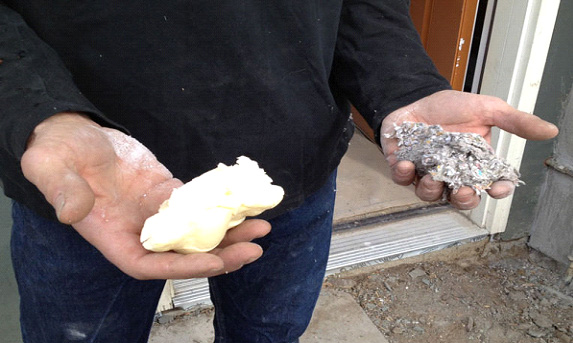 A local builder in a Denver neighborhood shows off the environmentally friendly recycled newsprint insulation he has been working with since 2005 (right). But the city of Denver requires him to spray two inches of foam insulation (left) as a barrier in applications where there might be moisture. “So much for being Green”.
A local builder in a Denver neighborhood shows off the environmentally friendly recycled newsprint insulation he has been working with since 2005 (right). But the city of Denver requires him to spray two inches of foam insulation (left) as a barrier in applications where there might be moisture. “So much for being Green”.
Tens of millions of pounds of these flame retardant chemicals are being produced each year worldwide, with building insulation being the primary application. HBCD, the flame retardant added to polystyrene insulation, is currently being produced at a rate of 68 million pounds per year. Because of its highly bio accumulative nature, HBCD is poised to become the 22nd chemical banned under the Stockholm Convention. In animal studies, it interferes with hormones and affects the developing nervous system.
The situation with TCPP isn’t any rosier. Data from the year 2000 in the EU shows it was being produced at a rate of 88 million pounds per year. Unlike HBCD, it tends to associate with water rather than fat and accumulates in the kidneys and liver. TCPP is found globally in groundwater, wastewater, and wildlife. Unfortunately, even if we completely stop production tomorrow, HBCD and TCPP will be a problem for decades to come; the similarly persistent pesticide DDT is still causing reproductive problems for the endangered California condor and can be found in every person tested by the CDC despite its being banned since 1972.
This alludes to a larger story about regulation and the power of industry. We tend to think that consumer products in this country are generally safe – surely someone is watching to ensure that they are not harmful to us or to the environment. A few areas, like pharmaceuticals, do benefit from government oversight to ensure companies are cautious and deliberate before bringing products to market. But for the vast majority of the products that are introduced to the public each year, there is no requirement that manufacturers prove what they’re peddling is not harmful, even if it contains substances that have known track records in animal studies or other equivalent evidence of toxicity.
This industry-friendly approach is not the only model out there – it stands in sharp contrast to the EU’s Precautionary Principle that places the burden of proof upon manufacturers to demonstrate a product is not harmful before distributing it for sale. Given the high stakes of such persistent environmental pollutants, it seems reckless to pump them into the environment with no long-term management plan, particularly since there are safer alternatives. At least in this one instance, our efforts to “green” up our energy consumption may be digging us deeper into a very different environmental hole.
The good news, as today’s study suggests, is that these chemicals are in many cases unnecessary additions to building insulation. They can safely be removed without affecting fire safety. So, for once, we can have it all: buildings that are safe, energy-efficient, and easy on the environment.
Improving Codes for Foam Plastic Building Insulation
Current building codes regulating the flammability of plastic foam insulations such as polystyrene (EPS & XPS), polyurethane, and polyisocyanurate:
- Are not proven effective in increasing overall fire safety
- Can lead to the use of flame retardant chemicals that are toxic or lack adequate testing
- Would benefit from revision
The flame retardant HBCD (hexabromocyclododecane) used in polysyrenes is a global contaminant scheduled to be banned as a persistent organic pollutant under the Stockholm Convention.
The flame retardant TCPP (1-chloro-2-propyl) phosphate is often used in polyurethane and polyisocyanurate foam. It is a possible carcinogen and needs more study.
Since 1961, foam plastic insulations must meet flame spread and smoke developed requirements measured by ASTM E 84, the Steiner Tunnel test.
The New Construction Materials may have an Immediate or negative effect on your health. Within 5 minutes of entering a kitchen, your nose may burn, and soon after, your throat. You may get a headache, and your eyes begin to itch. You could smell the formaldehyde outgassing from new products. Our Government has eliminated this from many domestic products.
Note the word is Domestic….
RCM Pick
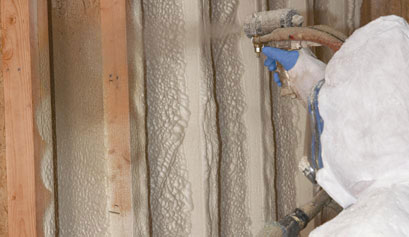
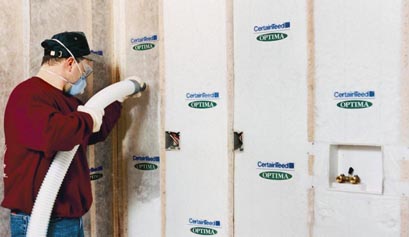
Spray Foam Insulation
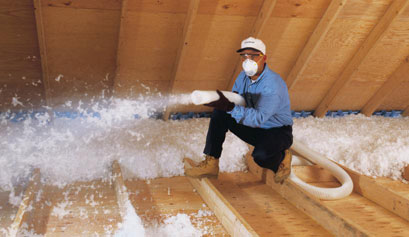
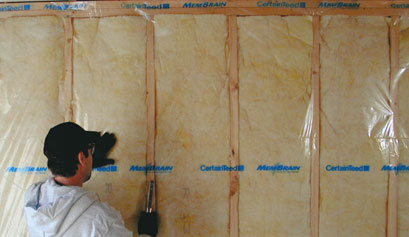
Fiber Glass Insulation
Walls: One inch closed cell foam for air sealing and insulation value between the studs followed by blown-in fiberglass insulation to a density achieving its maximum R value and covered with Certainteed MemBrain SVR which changes its permeability based on conditions.
Attic: Closed cell foam (1 inch) for air sealing at rim joists and ceiling, followed by blown-in fiberglass insulation to achieve R- value (Minimum R-38).
Advantage: High R value, excellent air sealing, excellent moisture control, fills gaps and voids, great value vs. cost.
Disadvantage: Higher initial costs, complex installation, should be installed by qualified certified installer.
Total Cost: $ 9,856.00 for a 3900 Sq. Ft. Home………… Avg. Cost… $ 2.53 Sq. Ft.
Insulation Systems:
- www.knaufusa.com/products/building_insulation/residential_insulation/ecoseal™_sealant.aspx
- www.knaufusa.com/products/building_insulation/residential_insulation/knauf_jet_stream®_ultra.aspx
Green Pick
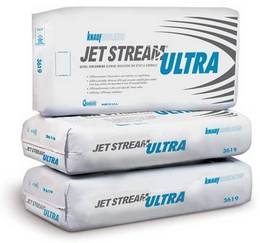
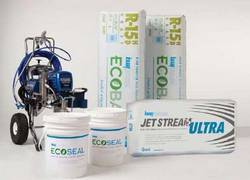
Walls: Eco Seal sealant combined with EcoBatt Insulation or Knauf Premium filled with Knauf Jet Stream Ultra (BIBS) Blowing Insulation to R-15(2x4) or R-23 (2x6). Water-based elastomeric spray that seals penetrations and joints in the building envelope, including exterior walls, attics and floors. EcoSeal dries to a flexible tough film and has great bond strength with low odor and is extremely low in V.O.C’s. EcoSeal should be used with Knauf Insulation EcoBatts® or Knauf Premium Blowing Insulation. Together, they are known as the EcoSeal System. The Eco Seal system forms an effective, continuous and affordable air and thermal barrier for the building envelope.
Attic: Blown in insulation to desired R value (R-38 minimum).
Advantage: High R value, air sealing, mostly natural and recycled materials used in manufacturing, fills gaps and voids.
- Client will receive a considerable energy saving delivers air flow resistance to the whole structure, not just the cavities.
- Seals areas traditional spray foams cannot. Trade-friendly, no schedule delays.
- Unlike many foams, Eco Seal does not involve mixing hazardous chemicals at the jobsite, nor does it generate hazardous off-gassing during cure. Therefore, Eco Seal is safe to spray and dries quickly—so other trades stay on site and on schedule.
Disadvantage:
- Higher initial costs.
- Payback in investment will take over 10 Years.
- Air balance may be needed as a result of air tight building.
Total Cost: $ 23,478.00 for a 3900 Sq. Ft. Home ….… Avg. Cost per Sq. Ft $6.03
For More Information:
Green Builder Advisor: www.greenbuildingadvisor.com
Safer Insulation Solution: saferinsulation.greensciencepolicy.org
Kalliopi Monoyios is the illustrator of two popular science books: Neil Shubin’s Your Inner Fish, and Jerry Coyne’s Why Evolution is True. Her illustration portfolio can be found at kalliopimonoyios.com. Follow her on Twitter at @eyeforscience and with co-blogger Glendon Mellow at @symbiartic. Follow on Twitter @symbiartic.

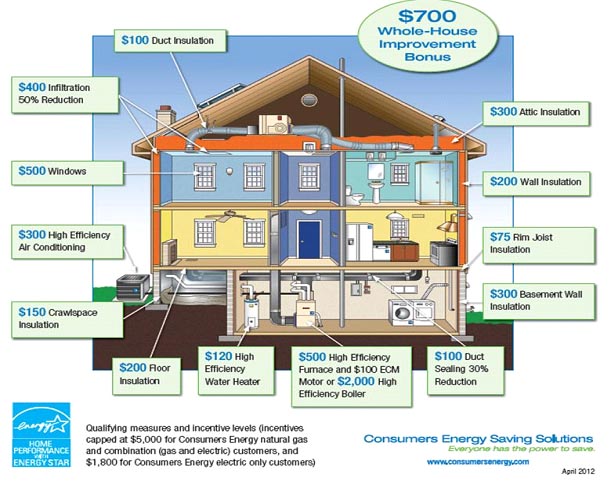

Stay Connected